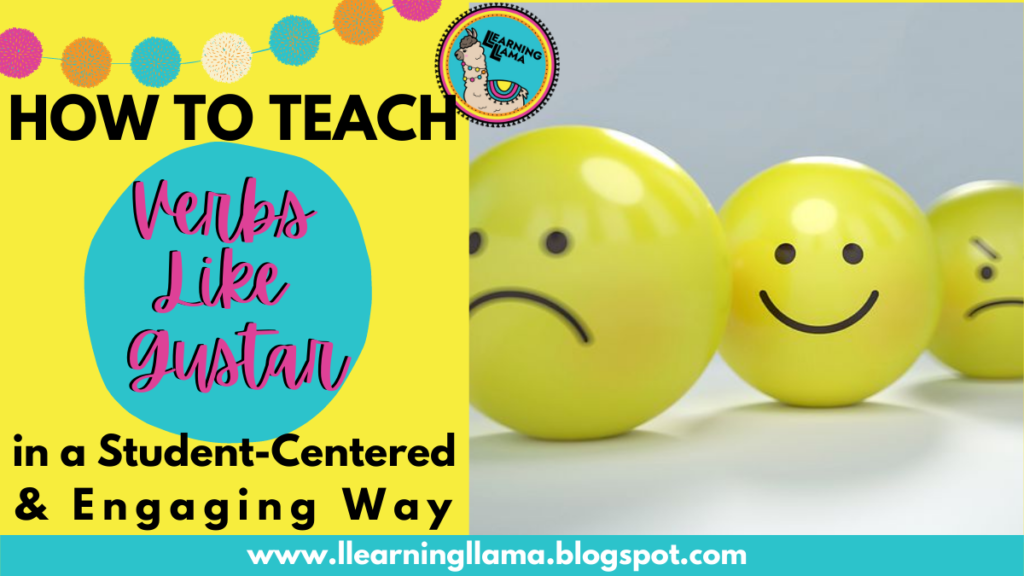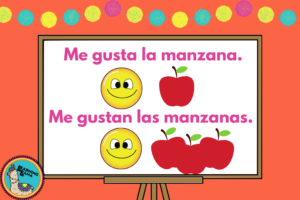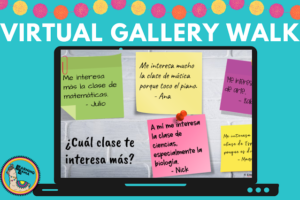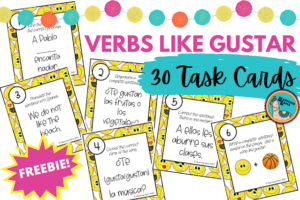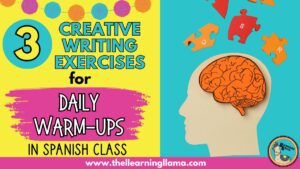Are you struggling to teach verbs like gustar to your Spanish students in a more engaging, student-centered way? Do you find yourself bored with using typical grammar activities, like fill-in-the-blank and mundane worksheets? Verbs like gustar are usually some of the first “grammar” lessons that our students encounter in the target language, and we don’t want them to be bored or discouraged from the get-go. Try some of these student-centered grammar lessons to make your verbs like gustar lessons exciting, engaging, and memorable. Plus, keep reading to snag your Verbs Like Gustar Task Cards Freebie below!
How to Teach Student-Centered Grammar: Verbs Like Gustar
To begin, let’s think about how you normally introduce “verbs like gustar.” Do you typically explain the grammar rules to your students as they take notes, and then you ask them to practice with fill-in-the-blanks? That sounds like a pretty basic lesson, not filled with much student participation or excitement for learning, doesn’t it? So, how do you introduce a grammar concept in a student-centered, enthusiastic way? Through an inductive approach!
Inductive Grammar for Verbs Like Gustar
Let’s dive into what an inductive approach grammar lesson looks like. Through this teaching method, your students will be the ones to “discover” the rules of verbs like gustar. You will not tell them the rules, but you will guide them to help them discover these rules on their own. To start the lesson, you can write two sentences on the board. “Me gusta la manzana” and “No me gusta la manzana” Be sure to include a good amount of visuals so students can comprehend the sentences, like in the example below. From there, you should show your students other objects or images and get their response. Maybe you show “un elefante,” or “un libro,” or “el chocolate.” Be sure to use words that your students know and ask them to respond with how they feel: “Me gusta el elefante.” or “No me gusta el elefante.”
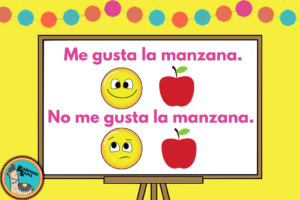
Next, we have to introduce singular versus plural objects of the sentence. Again, you will need to write two sentences on the board. “Me gusta la manzana” and “Me gustan las manzanas.” Now, ask your students what they notice? Rather than simply stating the rule for them, let them come up with the rule, let them discover the grammar. They will not only be proud of themselves for realizing it, but they will be eager to try to explain how they came to the conclusion. From there, they can begin practicing. Use your props; use lots of visuals! Show more than one elephant now. Will students say “me gusta or me gustan los elefantes.” This is also the time to ask why they chose that response. We always say that the best way to learn is to teach. When students are actively involved in the learning/teaching process, they will grasp the material faster and put it into use more accurately. If you’re looking for great emoji clipart, like the ones you see here, check out Lisa Markle Sparkles TpT Store!
Once you’ve introduced the grammar concept, your students are ready to practice! Here are some of my favorite ways to practice and review verbs like gustar after you have used the inductive approach.
10 Activities for Teaching Verbs Like Gustar
1. 4 Corners
Put 4 basic phrases in each corner (such as: me gusta(n), no me gusta(n), me encanta(n), no me encanta(n)) Display an image, hold up a prop, or say a word. Students move to the corner of the room that best fits their opinion of the item. Then, to encourage conversation in the target language. They should say a complete sentence with their group. For more advanced students, they can elaborate and explain why they like or dislike that item.
2. Gallery Walks
Create questions using verbs like gustar, print and hang questions around the room. (You can also do a
digital version of this – link here!) Then, give students a handful of post-it notes. They will walk around the room, reading the questions. As they get to each question, they will write their response on a sticky note and then post their response next to the question. After everyone has responded to the questions, they can walk around and view each other’s response. If your students are able to ask questions in the target language, they can write questions on the post-its to start a silent conversation. For example, if someone writes “Me encanta jugar fútbol.” During the post-gallery walk activity, a student could ask “Tienes un equipo favorito?” Then students will continue walking and respond to the questions that they receive.
3. Task Cards
This is a more interactive, fun take on grammar drills. This
set of 30 task cards for FREE gets students to complete a variety of verbs like gustar activities, such as fill-in-the-blank, short answer, pronoun practice, and more! With the download, you will get a list of games and activities that are best to do when using task cards!
4. Stations
When reviewing grammar, I always think that stations are one of the best possible activities. For one reason, it gives students a bunch of review activities, meeting the needs and learning styles of multiple student types. It also gives you, as the teacher, time to meet with struggling students. You can sit at one specific station that is more difficult, you can rotate around, or you can pull individual or small groups of students to the side and work with them on their tasks. Some great Stations activities include individually paced
Pear Deck,
the task card freebie,
self-checking Google Forms quizzes,
worksheets, and more! You can get a great
Verbs Like Gustar bundle here that will supply you with an entire class period worth of Stations material!
5. Padlet
Create a Padlet for each class, and add two text boxes (one on each side of the padlet – me gusta and no me gusta). Once you have shared the Padlet with your class, have each student make a sticky note with their name. You will say an item or show a picture, as students see or hear. They will move their name to the side of the Padlet for how they feel about it.
6. Draw It!
Post the different verbs like gustar phrases around the room on posters or on the wall: me fascina, me importa, me encanta, no me interesa. Students will each be given a few small pieces of paper. As they see the different verbs like gustar phrases, they will think of an item or activity for each phrase, draw it, and then tape it to that poster or on the wall. I might draw a science beaker for “no me interesa” because science is a subject that I don’t enjoy that much, but for “me encanta,” I would draw a Spanish flag because Spanish class is my favorite! After everyone has drawn and posted images, you can ask them to write or say complete sentences about what they drew.
7. Walkaround
Find someone that likes… This activity gives students practice repeating the verbs like gustar questions/answers over and over again. Create a worksheet with 20 squares. In each square write a vocab word or phrase, such as el chocolate, tocar el piano, pasar tiempo con amigos, la playa. The goal is for students to walk around the classroom and find one student who likes each of the 20 things. They must ask and respond in the target language! For example: Person A: ¿Te gusta el baloncesto? Person B: No, no me gusta el baloncesto. They ask again until someone says yes. When someone says “yes,” they sign their paper in that box. Here is an image of a Walkaround for imperfect verbs that I use when teaching “la niñez.”
8. YouTube Videos
To talk about what other people like to do, you can watch videos or shorts. One of my favorite types of videos to use in the world language classroom is Mr. Bean. They are silent videos, but filled with comedy, energy, and lots of action to describe. You can find a Mr. Bean video (or as we call him in my classes, Sr. Bean) for almost any type of vocabulary – daily routine, food, holidays, etc. Ask students “¿Qué le gusta a Sr. Bean?” Other great videos are Pixar shorts or other shorts because they are usually short silent films, allowing students to generate descriptions on their own.
9. Pass the Sentence
Students should sit in a circle or in a row. Every student begins with a blank sheet of paper and writes just one word to start a sentence. Maybe “a” or “te,” and then they pass it to the next person in the class. The following student writes the second word in the sentence, such as “mí” or “gustan,” and students continue to pass until the sentence is complete! By the end, they should have sentences such as “A mi me importan las notas.” or “¿Te gustan las películas de horror?
10. Emoji & Drawing Sentences
We all know that students love to use their emojis. You can create sentences based on emojis, such as the example below. Create a worksheet or Google Slides with a bunch of emoji sentences. Then students will write sentences in the target language based off of the images. You could also have students design their own emoji sentences, then they switch with a partner. Hey, that’s even less work for you! These types of questions can be found in the
Verbs Like Gustar task card FREEBIE, so you can get some examples and practice before kids make their own emoji sentences.
Now that you have some new techniques to introduce verbs like gustar and to practice, let me know what you try out and how it works! Which activities are your students’ favorites? And again, don’t forget to snag your
verbs like gustar task card freebie!

